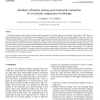Free Online Productivity Tools
i2Speak
i2Symbol
i2OCR
iTex2Img
iWeb2Print
iWeb2Shot
i2Type
iPdf2Split
iPdf2Merge
i2Bopomofo
i2Arabic
i2Style
i2Image
i2PDF
iLatex2Rtf
Sci2ools
AES
2008
Springer
2008
Springer
Ambient vibration testing and structural evaluation of an historic suspension footbridge
The paper summarises the ambient vibration-based assessment of an historic suspension footbridge, dating back to 1928. The footbridge is characterised by the timber floor system supported by two couples of cables, that were recently replaced. After the retrofit, the actual structural behaviour of the bridge were assessed by experimental and theoretical methods. The field tests included geometric survey of the deformed configuration due to dead loads, ambient vibration measurements and static load tests. The peak picking and the enhanced frequency domain decomposition techniques were used to extract the modal parameters from ambient vibration data and a very good correlation among the modal parameters identified from the two techniques has been found. Successively, the information obtained from the dynamic tests, combined with classic techniques of system identification, were used to adjust some parameters of a 3D finite element model of the footbridge. The results of the live load tes...
| Added | 08 Dec 2010 |
| Updated | 08 Dec 2010 |
| Type | Journal |
| Year | 2008 |
| Where | AES |
| Authors | C. Gentile, N. Gallino |
Comments (0)

